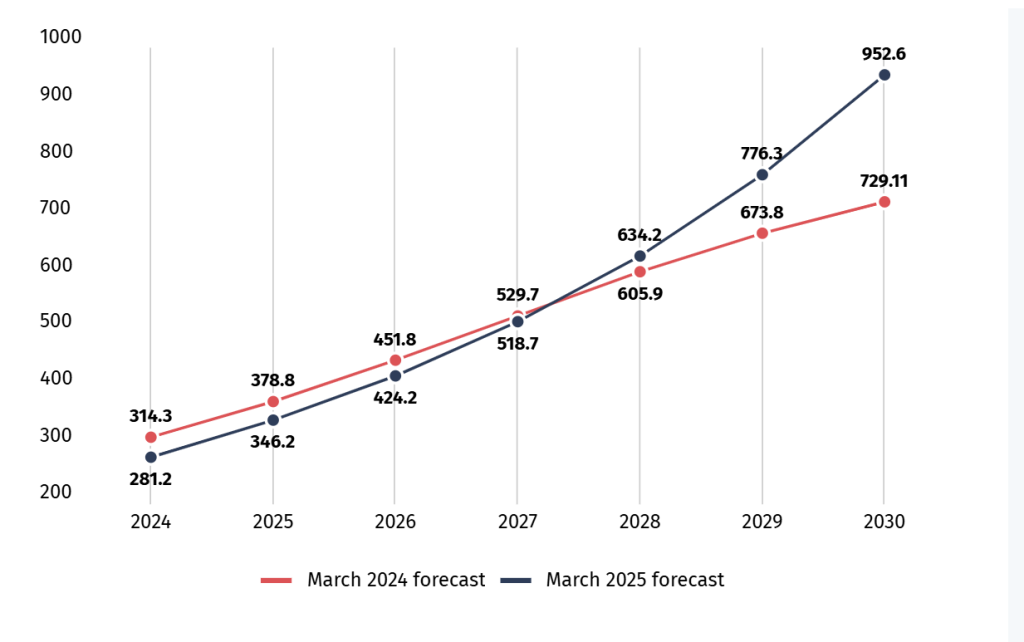AI usage has surged from 115 million users in 2020 to 350 million today. Projections show the global AI user base will reach 950 million by 2030, 220 million more than previously forecasted. This rapid growth is expected to continue, with 1.1 billion users by 2031.

The global Artificial Intelligence (AI) market is experiencing an unprecedented rate of growth. From a user base of approximately 115 million in 2020, AI usage has tripled in just a few years, reaching nearly 350 million today. This rapid rise is part of a broader technological revolution that is reshaping industries and daily life, with AI now being employed across sectors like healthcare, retail, manufacturing, and finance to enhance efficiency, decision-making, and customer experiences.
Recent projections have revealed that the growth of AI is far outpacing earlier expectations. According to data from Statista, the global AI market is set to surpass 950 million users by 2030—an increase of 220 million from previous forecasts. This acceleration in growth signals that AI is not just a passing trend, but a fundamental technology that is becoming integral to a wide variety of industries worldwide.
The latest market estimates also highlight a significant surge in the adoption of AI tools, with seven consecutive years of accelerating growth ahead. In 2025 alone, the AI user base will expand by 65 million people, followed by an additional 78 million in 2026. This pace continues to rise, with projections indicating that 95 million people will start using AI tools by the end of 2027, and over 115 million new users will join the market by 2028.
By 2030, the total number of AI users is expected to reach 952 million, with a final push in the last few years bringing in an additional 176 million users.
A snapshot of AI’s rapid growth and its global impact
Just five years ago, AI was still a developing technology, primarily used by early adopters and in niche applications. However, its exponential growth has positioned it as a mainstream technology. The widespread adoption of AI is transforming how businesses operate, from automating tasks to driving predictive analytics in sectors like stock trading, customer service, and even healthcare.
A key factor contributing to this expansion is the increasing accessibility of AI tools. AI is no longer limited to large enterprises and tech giants but has found a place in businesses of all sizes. Startups and small businesses are now integrating AI solutions to boost operational efficiency, improve customer engagement, and create innovative products.

Continued growth beyond 2030: A billion users by 2031
Looking further ahead, AI’s adoption is expected to continue growing rapidly. Statista projects that by 2031, AI could have a global user base exceeding 1.1 billion people. If these projections hold true, AI will become as ubiquitous as smartphones and social media, with the potential to reshape entire industries and societies.
This growth is expected to follow a trajectory similar to the early internet and smartphone adoption, with AI becoming an essential part of daily life. By 2031, AI’s user base will surpass the combined populations of Europe and the United States, solidifying AI’s position as a transformative global force. If it were a country, the AI user base would be the third-largest in the world, behind India and China.
The road ahead: What this means for businesses and consumers
The rapid growth of AI is not just about numbers; it is reshaping how businesses operate and how consumers interact with technology. As AI continues to evolve, we can expect more innovative applications and widespread integration across industries, from autonomous vehicles and AI-powered personal assistants to advanced medical diagnostics and precision agriculture.
For businesses, this presents a significant opportunity to leverage AI for growth and competitiveness. However, it also presents challenges, particularly around data privacy, ethics, and the potential for job displacement due to automation. As such, companies will need to embrace AI responsibly, ensuring that their adoption strategies align with ethical standards and regulatory frameworks.

Himani Verma is a seasoned content writer and SEO expert, with experience in digital media. She has held various senior writing positions at enterprises like CloudTDMS (Synthetic Data Factory), Barrownz Group, and ATZA. Himani has also been Editorial Writer at Hindustan Time, a leading Indian English language news platform. She excels in content creation, proofreading, and editing, ensuring that every piece is polished and impactful. Her expertise in crafting SEO-friendly content for multiple verticals of businesses, including technology, healthcare, finance, sports, innovation, and more.









